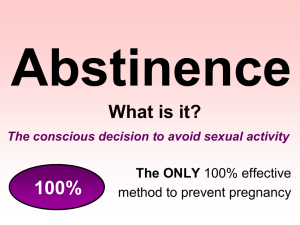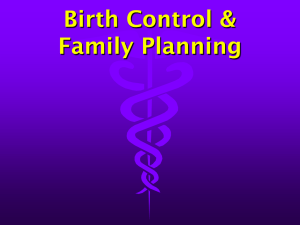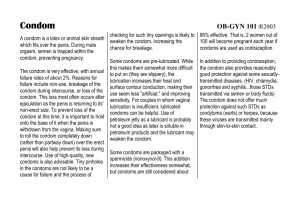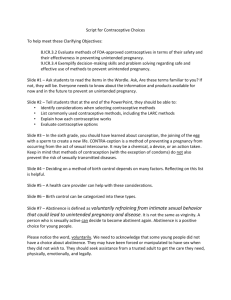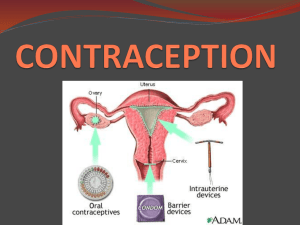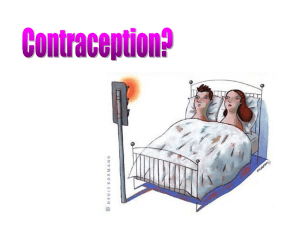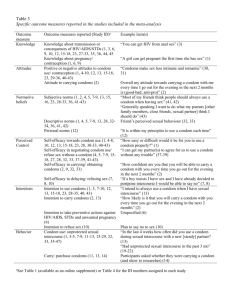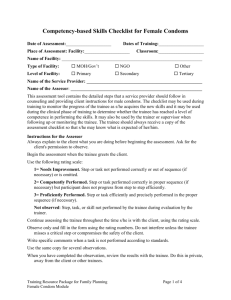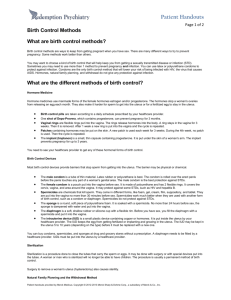A8xa2afx8x1
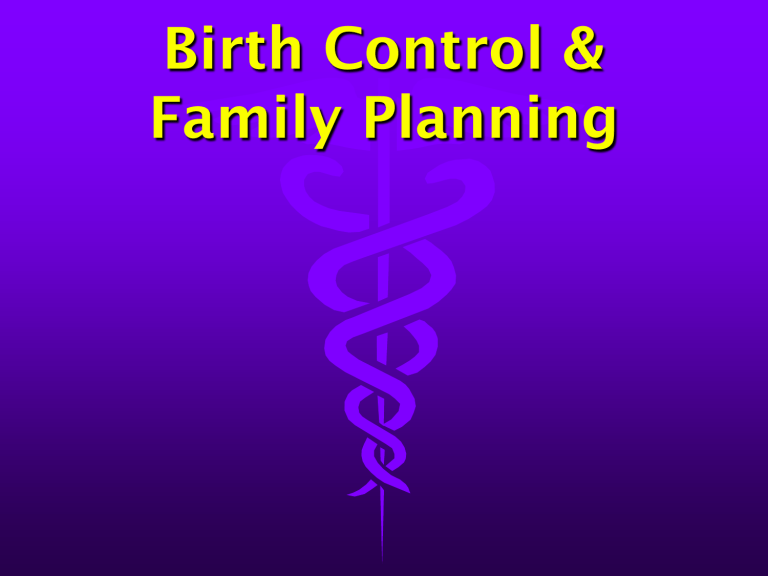
Birth Control &
Family Planning
Birth Control Methods
Condoms (male and female)
Spermicidal Foam or Jelly
Vaginal Contraceptive Film
Birth Control Pills
Orthro-Evra® Patch
Nuva Ring®
Depo-Provera® Information
IUD (Intrauterine Device)
Birth Control Pills
Pills can be taken to prevent pregnancy
Pills are safe and effective when taken properly
Pills are over 99% effective
Women must have a pap smear to get a prescription for birth control pills
How does the pill work?
Stops ovulation
Thins uterine lining
Thickens cervical mucus
Positive Benefits of Birth Control Pills
Prevents pregnancy
Eases menstrual cramps
Shortens period
Regulates period
Decreases incidence of ovarian cysts
Prevents ovarian and uterine cancer
Decreases acne
Breast tenderness
Nausea
Increase in headaches
Side-effects
Moodiness
Weight change
Spotting
Taking the Pill
Once a day at the same time everyday
Use condoms for first month
Use condoms when on antibiotics
Use condoms for 1 week if you miss a pill or take one late
The pill offers no protection from
STD’s
Spermicides:
Contraceptive foam, gels, suppositories, and film contain chemicals that kill sperm.
They are inserted into the vagina before intercourse and should be used with a condom.
75%-80% effective if used alone
98% effective if used with condom
Spermicides-Side Effects
Allergic reaction
Burning or irritation
BARRIER METHOD
Prevents pregnancy blocks the egg and sperm from meeting
Barrier methods have higher failure rates than hormonal methods due to design and human error
MALE CONDOM
Perfect effectiveness rate = 97%
Typical effectiveness rate = 88%
Latex and polyurethane condoms are available
Combining condoms with spermicides raises effectiveness levels to 99%
MALE CONDOM
Thin membrane made of latex, polyurethane or sheepskin that fits over the erect penis to catch semen when the male ejaculates.
Condoms protect against some STI’s and unwanted pregnancy.
Have a reservoir tip to collect semen at ejaculation
How to Use a Male
Condom
Check package for expiration date
Open package carefully (not with teeth!)
Use a water based lubricate if needed
Put condom on before you begin to have sexual intercourse-before penis touches other person
Place the unrolled condom on the head of the erect penis.
With one hand squeeze the air out of the tip of the condom, and with the other hand unroll the condom to the base of the penis
After ejaculation, before the penis becomes limp, withdrawal the penis holding the rim of the condom to the base of the penis
Dispose of used condom in trash, not toilet!
FEMALE CONDOM
Made as an alternative to male condoms
Polyurethane
Physically inserted in the vagina
Perfect rate = 95%
Typical rate = 79%
Woman can use female condom if partner refuses
Female Condom
Depo-Provera
Birth control shot given once every three months to prevent pregnancy
99.7% effective preventing pregnancy
No daily pills to remember
How does the shot work?
Stops ovulation
Stops menstrual cycles!!
Thickens cervical mucus
SIDE EFFECTS
Extremely irregular menstrual bleeding and spotting for 3-6 months!
NO PERIOD
after 3-6 months
Weight change
Breast tenderness
Mood change
*NOT EVERY WOMAN HAS SIDE-EFFECTS!
NuvaRing
Flexible contraceptive vaginal ring that contains the hormones estrogen and progesterone.
The ring releases a continuous low dose of hormones that stops the ovaries from releasing an egg each month.
NuvaRing
Insert the ring in the vagina and leave it there for three weeks
Remove the ring for one-week ring-free period, on the same day of the week at about the same time. During the one-week break, you will usually have your menstrual period.
Side effects
Possible side effects are the same as birth control pills.
They may include breast tenderness, headache, nausea, and spotting. Most side effects are not serious and often go away.
Women who use hormonal contraception should not smoke
Ortho Evra (The Patch)
Transdermal contraceptive patch that contains estrogen and progesterone
The patch is thin, beige, flexible , two inch square that is worn on the body.
The increased hormone level caused by the patch stops the ovaries from releasing an egg each month
How it works
99% effective
Apply patch one week on the same day each week for three weeks
Can wear it on bottom, abdomen, torso, or on the outside of your upper arm
During week four do not wear the patch(your period will begin)
Side effects
Breast tenderness
Headache
Skin irritation
Nausea
Increases blood clot
What is it?
Emergency contraception (EC) is a safe and effective way to prevent pregnancy after unprotected intercourse. It can be started up to five days (120 hours) after unprotected intercourse.
WITHDRAWAL
Removal of penis from the vagina before ejaculation occurs
NOT a sufficient method of birth control by itself
Effectiveness rate is 80%
– is not recommended for teens and sexually inexperienced men because it takes lots of experience before a man can be sure to know when he's going to ejaculate
Very difficult for a male to ‘control’
How effective is it?
Of every 100 women whose partners use withdrawal, 4 will become pregnant each year if they always do it correctly.
Of every 100 women whose partners use withdrawal, 27 will become pregnant each year if they don't always do it correctly.
Pregnancy is also possible if semen or pre-ejaculate is spilled on the vulva.
Natural Family Planning &
Fertility Awareness Method
Women take a class on the menstrual cycle to calculate more fertile times
Requires special equipment and cannot be self-taught
NFP abstains from sex during the calculated fertile time
FAM uses barrier methods during fertile time
Perfect effectiveness rate = 91%
Typical effectiveness rate = 75%
No 100% safe day-irregular periods
EXCELLENT REFERENCE SEE: www.plannedparenthood.org
Review
